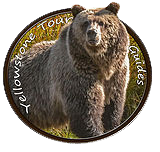A Yellowstone Guide Spots 13 Wolverines Chasing Grizzlies
For decades people have visited Yellowstone National Park to get up close and personal with nature and the amazing wildlife that lives there. Guided Yellowstone tours are one of the best ways to see the park. With a trained tour guide, you can be sure that you will not miss any of the exciting aspects of this amazing place.
Recently, backpackers enjoying Yellowstone were treated to a rare encounter. While backpacking through the Teton wilderness, Yellowstone naturalist guide Doug MacCartney witnessed what many experts believed to be an unusual phenomenon. Recorded on film, MacCartney witnessed a large gathering of wolverines chasing grizzlies across the snow.
Mr. MacCartney admits that it is already a rare thing to see wolverines at all, but images of the event recorded about 13 wolverines congregated in the high alpine. It was obvious that they were foraging for food.
When grizzlies entered the area, MacCartney was then given the show of a lifetime, as the wolverines commenced chasing the grizzlies.
Mr. MacCartney was not alone during this interesting experience in Yellowstone as he had two companions with him. The backpackers were hiking toward a particular peak, which was their goal for the day. While transversing a bowl on the summit’s western side, an area that was almost flat, they noticed a mother grizzly with two cubs. They were far enough away to safely continue hiking, while carefully watching the bears’ movements from a distance.
The hikers then noticed that the bears had started running. They stopped to see why and that was when they could see a wolverine. The animal was moving off of a big rock and going straight in the bears’ direction. To their great surprise, they saw another wolverine and another headed after the bears. All three men witnessed this unusual occurrence.
Soon there were too many wolverines to easily keep track of, but the men claim it was at least 13. They observed the wolverines split up into two groups to more effectively chase the grizzlies out of the area.
Several experts were consulted following this encounter. After reviewing the photos that were taken, some experts believe that the animals clashed in this way in competition for food in the area. There were likely animal carcasses nearby that the wolverines had already claimed. This in and of itself is not unusual, but what was unusual was the fact that the wolverines were congregated.
Generally, wolverines do not behave this way, and they do not work together to protect food or to fight off invaders.
This could be a result of animal behavior evolving as space and resources become scarce.
Yellowstone National Park is full of amazing animal encounters and guided tours are one of the best ways to experience these marvels of nature.
